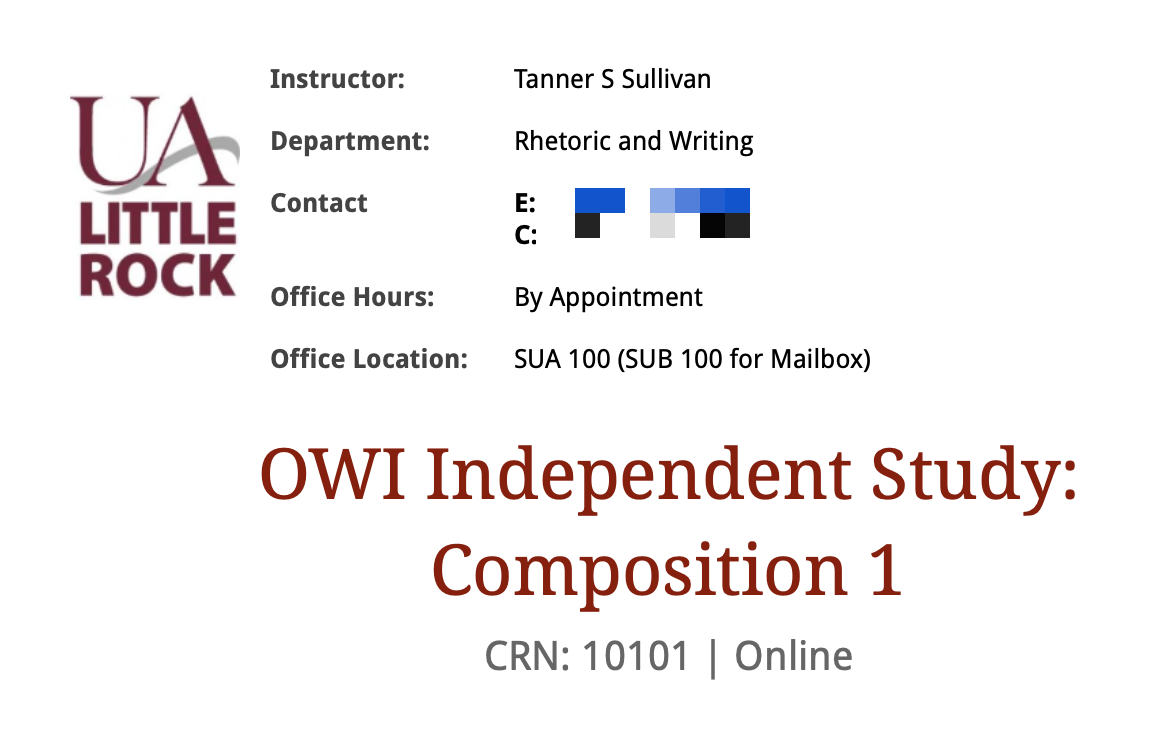
Project Description
Completed a graduate certificate in Online Writing Instruction (OWI) that provides writing teachers with graduate-level accredited professional development hours. Working with program learning outcomes to develop a lesson plan fit for an online learning enviornment using Learning Management Software (LMS) and open source tools. Each course in the program built on one another, leveraging concepts and even work to develop a comprehensive online writing class.
Learning Outcomes
- Continue to independently improve on OWI principles and effective strategies
- Create professional materials and strategies to build an online writing course for learners
- Continue to identify ways to embrace diversity
- Design for accessibility
- Share information that can help advance the OWI community
Reflection
Throughout this graduate certificate program, I gained valuable insights and skills that not only informed my work as an educator but as a technical writer too. It wasn’t something I expected going into the program. Education and my work in the tech industry felt separate - training users how to use software and teaching students about an area/subject of writing. (I didn’t know then what I know now, haha.) Instructors in program empowered me to pick topics that interested me which made my work more meaningful. Toward the end of the program, I was able to discuss real situations I experienced when training users and learned ways to improve my writing to better address the process or situation.
Earlier in the program, I was really focused on building on concepts from Composition Theory and my first (hybrid) Composition 1 course. Fresh on my mind, I was already aware of the difficulties of engaging with students in a course where students met only twice a week. I used the course time to go over topics and activities, but all content and assignments lived in open source and web-accessible formats. The nerdy kid from grade school who loved the idea of teaching thrived on taking in the tea from my mentors - leveraging open source materials with Google docs and Blackboard. But… student didn’t share the “vibe.”
Engagement during the face-to-face (f2f) sessions was great but I didn’t receive the same level of communication during the eLearning periods. Okay, being honest, a lot of this was my own expectations glaring at me - anxious about failing my students. I can gab on about almost anything all day, but teaching digitally wasn’t the same. Maybe it is the “send” button acting like a publish, the screens, or being overburdened with their own schedules, but something kept students from reaching out. Though this cycle usually ended with next week’s f2f class, I wanted out of the cycle. The goal was to communicate as well with students online as offline.
old
The work in this course taught me how to use different modes of communication to work with students in an online environment. This communication can go beyond an online-only environment to a hybrid environment. This allows me, as an instructor, to communicate with my students in different ways (e.g., video lessons) to reach them more effectively than just comments on a paper or written feedback.
I was able to take what the introduction course taught and work these goals into specific assignments. I didn’t learn as much about accessibility as I wanted to, which may require me to use the software or work with disability services to “walk a mile in someone else’s shoes.” In terms of making content available for students, I utilized Working in Google Sites to build an online class in such a short time felt vastly different from teaching in a hybrid course.
Outside of the Composition class, the work throughout this program helped me to be a better technical writer. Working with learners from across the world, I couldn’t just send SOPs covering software functionality. To successfully teach new processes, I had to work with learners to gain insight into their duties and responsibilities to contextualize the software solution. Without a Learning Management System (LMS), I only had access to email communication and document organization to create a full training plan.